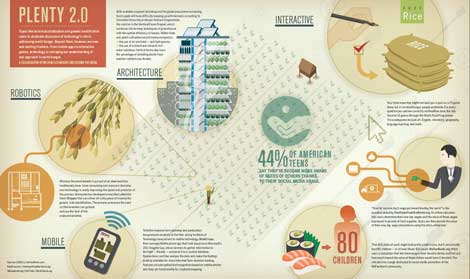Topics like farm industrialization and genetic modification seem to dominate discussion of technology’s role in addressing world hunger. Beyond them, however, are new and exciting frontiers. From mobile apps to interactive games, technology is reshaping our understanding of and approach to world hunger. To see the illustration of these innovations that appeared in the July-August 2011 issue of Miller-McCune magazine, click the image below.
Robotics
Whereas the plant breeder’s pursuit of an ideal seed has traditionally been time-consuming and resource-intensive, new technology is vastly improving the speed and precision of the process. Monsanto has developed a machine called the Corn Chipper that can shave off a tiny piece of a kernel for genetic trait identification. The process preserves the seed so that breeders can go back and use the best of the analyzed varieties.
Architecture
With available cropland shrinking and the global population increasing, food supply will have difficulty keeping up with demand, according to Columbia University professor Dickson Despommier. His solution is the Vertical Farm Project, which combines the farming techniques of greenhouses with the spatial efficiency of towers. Rather than soil, plant cultivation would involve aeroponics — the use of air and mist — and hydroponics — the use of nutrient and mineral-rich water solutions. Vertical farms also have the advantage of shielding plants from weather-related crop threats.
Mobile Apps
To better improve farm planning and production, two graduate students at the New Jersey Institute of Technology have turned to mobile technology. MobiCrops, their concept mobile phone app that took top prize in Microsoft’s 2011 Imagine Cup, allows farmers to gather information in the field — literally — and send it to a central database. Researchers can then analyze the data and make the findings publicly available for more informed farm decision-making. Features include optical leaf recognition based on mobile photos and drop-pin functionality from cropland mapping.

Interactive
Your trivia expertise might not land you a spot on a TV game show, but it can feed hungry people worldwide. For every question you answer correctly on FreeRice.com, the site donates 10 grains through the World Food Programme. Trivia categories include art, English, chemistry, geography, language learning and math.
“How far can one day’s wage go toward feeding the world” is the question asked by OneDaytoFeedtheWorld.org. Its online calculator lets users determine their one-day wages and the value of those wages expressed in pounds of food supplies. Users can donate the value of their one-day wage calculations using the site’s online tool.
• • • • • • • • • • • • • • •
That $20 plate of sushi might look pretty small to you, but it can actually feed 80 children — or at least the $20 could. WeFeedback.org offers users a calculator that lets them plug in their favorite dishes and find out how much impact the value of those dishes would have if donated. The site also has a page dedicated to social media promotion of the WeFeedback community.
This issue’s Graphic Art was a collaboration between Miller-McCune and Column Five Media.
Sign up for the free Miller-McCune.com e-newsletter.
“Like” Miller-McCune on Facebook.
Follow Miller-McCune on Twitter.
Add Miller-McCune.com news to your site.



